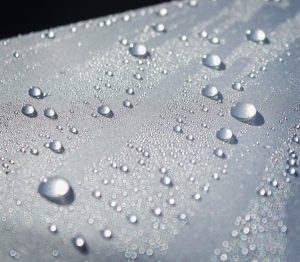HYDROPHOBICITY
Hydrophobic surfaces allow for water to bead and run off the radome surface rather than sheet and create a thin film of water which would have a negative effect on RF transmission. A hydrophobic surface allows the system to operate in heavy rain conditions with less effect on performance compared to a non-hydrophobic surface.

Our radomes are fabricated using a UV-stabilized hydrophobic coating that is integrated into the panel during lamination unlike paint which is applied after the lamination process. Integrating the surface coat during lamination creates a strong chemical bond between the coating and the panel resulting in a long-lasting, durable finish that requires minimal maintenance.
Post applied super-hydrophobic coatings with contact angles exceeding 120 degrees are available, however, these coatings are not as durable and will likely require re-coating the radome every four to seven years. The coatings utilized by ITI-RCS can be applied in the field without requiring disassembly of the radome.
